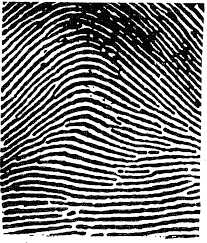The search method that doesn't have a formal geometric pattern or is easily definable
Link Method
Sometimes used in forensic cases to help determine the truthfulness of someone who may be connected to a possible crime.
Polygraph/Lie Detector Test
The term for someone that has just died
Decedent
Name the four fingerprint patterns
Arch, tented arch, loop and whorl
The component of hair that gives it color
Cortex
What are the four main blood types
A, B, AB, O
The outer most part of a hair
Cuticle
Used on large, outdoor crime scenes. Searchers follow the first line pattern and search in the same manner as the line method. Once the first line pattern is complete, searchers realign on the other line pattern.
Grid Method
The physiological data (vital signs) that is measured while conducting a polygraph...
Blood pressure, heart rate, respiratory rate, and skin conductivity
The name of the decedent in PLTW who has just died
Anna Garcia
Can two people have the same fingerprints?
No
Tiny fragments of physical evidence, such as hairs, fibers from clothing or carpeting, and pieces of glass.
Trace evidence
The blood type associated with agglutination in both the Anti-A antibody and the Anti-B antibody wells
AB
The part of the hair that is responsible for its color
Cortex
Used on large, outdoor crime scenes. Members of the search team are arranged at regular intervals, usually arm’s length, and then proceed to search along straight lines.
Line (or strip) Method
The type of questioning used at the beginning of an interrogation
Baseline questioning
Signs, items, or material that supports, or corroborates a crime
Evidence
Finger print pattern that slopes up and down resembling a mountain

Arch
A type of evidence found on electronic devices that store data, such as computers, smartphones, or tablets
Digital Evidence
The blood type associated with agglutination in neither the Anti-A serum or Anti-B serum
O
What are some things that investigators can tell about a person's hair beside length, color, or whether it's curly, straight, etc...
Age and gender
Used on crime scenes that are comprised of readily definable areas, such as in houses or buildings.
Zone Method
The types of questions a polygraph uses
Yes/No questions
Someone who law enforcement thinks may have information related to a possible crime.
Person of Interest
Finger print pattern where ridges curve to form a circular shape

Whorl pattern
True / False: Fingerprint patterns can change over time
(T/F)
False. Patterns don't change. Minutiae can.
The blood type that is the universal donor
O
The inner most part of a hair shaft. Can be absent with some hair types
Medulla
Used on crime scenes with no physical barriers, such as open water. Can either begin at the center and move
Spiral Method
The reason why polygraphs are not admissible in court
Not always accurate, and some people can manipulate their responses
Branch of science that analyzes evidence for investigative purposes regarding criminal and civil matters.
Forensic Science
How many minutiae points do you need for a positive match?
12
The act of tainting, polluting, or defiling evidence
Contaminating
The blood type that is the universal recipient
AB
What is the main protein found in hair?
Keratin